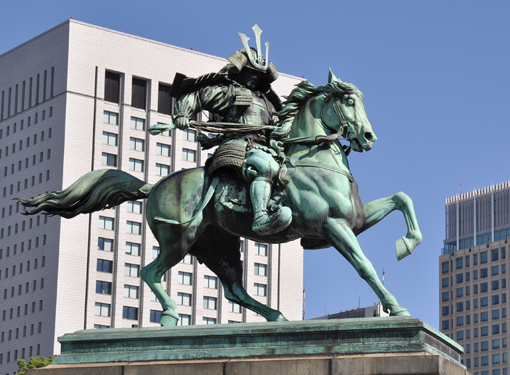Artist:
Takamura Koun
Title:
Kusunoki Masashige
Year:
1930
Adress:
Imperial Palace Plaza
www.wikipedia.org:
Kusunoki Masashige (1294 – July 4, 1336) was a 14th-century samurai who fought for Emperor Go-Daigo in the Genk? War, the attempt to wrest rulership of Japan away from the Kamakura shogunate and is remembered as the ideal of samurai loyalty.
His origin has not been validated and it was merely six years between the start of his military campaign in 1331 and his demise in 1336. He received the highest decoration from the Meiji government of Japan in 1880. "Legend has it that Emperor Go-Daigo had a dream in which he was sheltering under a camphor tree ("kusunoki"), and that this dream led him to the surname of the warrior who would support him."
Kusunoki "was a well-to-do member of the rural gentry" in the Kawachi Province. He claimed descent from Tachibana Moroye, "a great nobleman of the eighth century." Kusunoki was a "scholar and a devout Buddhist".
The Statue of Kusunoki Masashige built at Imperial Palace Plaza in Tokyo. The authors of the artwork are Koun Takamura (1852 - 1934) for mainly head part, Kisai Yamada (1864 - 1901) and Koumei Ishikawa (1852 - 1913) for body part and Sadayuki Goto (1850 - 1903) for horse part.
www.oldtokyo.com:
'Godaigo Tenno (A.D. 1334) was the Charles I of Japan. His subjects did not indeed cut off his head, but they rose against him under the ambitious leadership of the Ashikaga House, drove him into exile, and set up a rival on the throne. Like Charles I, he stood for the divine right of the Emperor; like him, his character seemed to improve with adversity; and like him, his virtues and fortitude won for him many devoted adherents, among them the noble Kusunoki Masashige, whose statue in bronze is one of the most conspicuous ornaments of the Maru no Uchi in front of the Imperial Palace.
'Masashige, defeated by his enemies, preferred suicide to a surrender to rebels against the Imperial House, and his equestrian statue in the Imperial park is a sign to all Japan that the present Government has, under happier auspices, revived the tradition of a divine-right-monarchy, for which Godaigo lost his throne, and Masashige his life.'
Every-day Japan, Arthur Lloyd, 1909
Kusunoki Masashige (1294 – July 4, 1336) was a 14th-century samurai who fought for Emperor Go-Daigo in the Genk? War, the attempt to wrest rulership of Japan away from the Kamakura shogunate and is remembered as the ideal of samurai loyalty.
His origin has not been validated and it was merely six years between the start of his military campaign in 1331 and his demise in 1336. He received the highest decoration from the Meiji government of Japan in 1880. "Legend has it that Emperor Go-Daigo had a dream in which he was sheltering under a camphor tree ("kusunoki"), and that this dream led him to the surname of the warrior who would support him."
Kusunoki "was a well-to-do member of the rural gentry" in the Kawachi Province. He claimed descent from Tachibana Moroye, "a great nobleman of the eighth century." Kusunoki was a "scholar and a devout Buddhist".
The Statue of Kusunoki Masashige built at Imperial Palace Plaza in Tokyo. The authors of the artwork are Koun Takamura (1852 - 1934) for mainly head part, Kisai Yamada (1864 - 1901) and Koumei Ishikawa (1852 - 1913) for body part and Sadayuki Goto (1850 - 1903) for horse part.
www.oldtokyo.com:
'Masashige, defeated by his enemies, preferred suicide to a surrender to rebels against the Imperial House, and his equestrian statue in the Imperial park is a sign to all Japan that the present Government has, under happier auspices, revived the tradition of a divine-right-monarchy, for which Godaigo lost his throne, and Masashige his life.'
Every-day Japan, Arthur Lloyd, 1909



